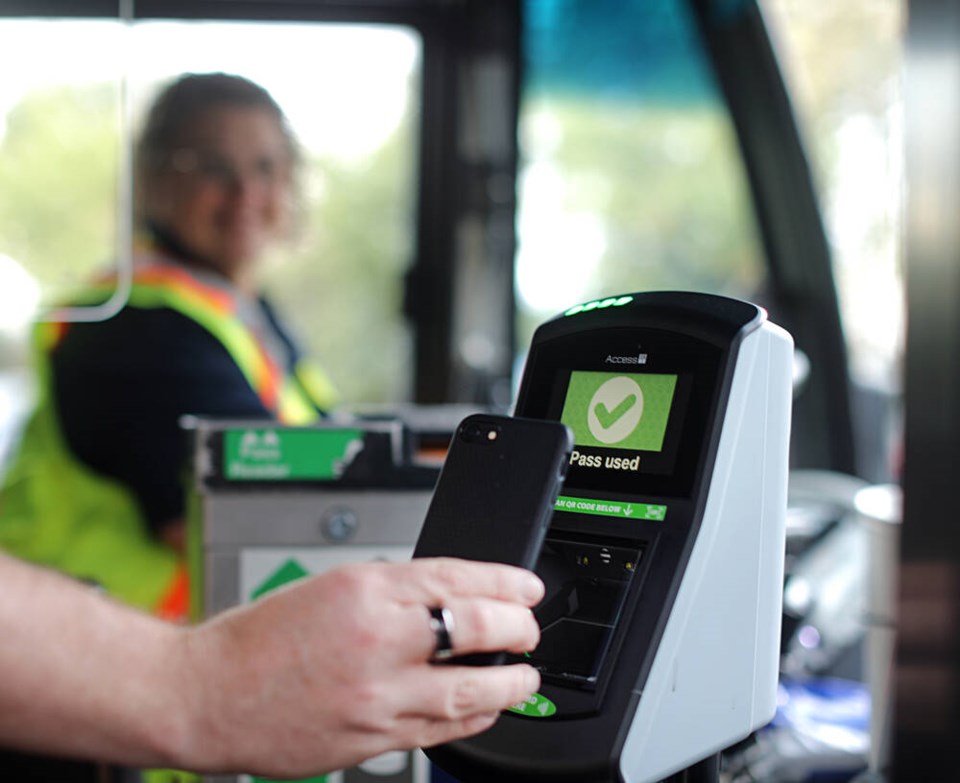B.C. Transit has launched Umo in Greater Victoria, an electronic-fare system designed to make bus travel easier.
Riders can pay by scanning a QR code displayed on a phone’s Umo app or by tapping a Umo card at new validator screens installed next to bus drivers’ seats.
Driver Martha Martinez has already seen Umo (pronounced “you-mo”) in action during the trial period for the technology and is a definite fan.
“It’s been amazing,” said Martinez, who often drives Route 75 to Butchart Gardens and thinks Umo will be a hit with tourists.
“I can show them where the app is and then they can use it throughout their visit, throughout Victoria,” she said.
Cash payments will still be accepted, but Martinez said Umo is a sign of the times.
“It’s moving into the new century and moving away from coin jams or tickets getting stuck or $5 bills getting stuck.”
She said she expects Umo to make things easier for both riders and drivers.
Central Saanich Mayor Ryan Windsor, who chairs the Victoria Regional Transit Commission, said during a launch ceremony at the Victoria Transit Centre on Wednesday that Umo will increase access to transit by allowing riders to pick the payment method that best suits them and their travel habits.
The old system required exact change, a ticket or a card.
Victoria is the first Canadian stop for Umo, which is owned and operated by Cubic Transportation Systems Inc.
The $23.2-million system will be added in the coming months to 29 other B.C. Transit systems across the province. Next to have Umo will be the Cowichan Valley, Nanaimo, the Comox Valley, Campbell River and Port Alberni.
The federal government paid 50 per cent of the cost, the province 40 per cent and local governments 10 per cent.
Dan Coulter, B.C.’s minister of state for infrastructure and transit, said supporting Umo to make the bus a more convenient travel option “is one more way that we are improving affordable, efficient, climate-friendly public-transit options as part of our CleanBC strategy to take on climate change.”
Coulter said Umo will be part of a tap-to-pay system by next year that will allow payments to be made with debit cards, credit cards and e-wallets. That option is seen as being especially beneficial for those who use transit only occasionally.
B.C. Transit’s Christy Ridout called Umo a “giant leap” for the transit system.
Ridout, vice-president of strategy and public affairs, said riders “will no longer need to search their couch or their house for exact change and you don’t need to head to a retail outlet to purchase your fare product.”
She said that the Umo system also offers trip-planning features such as maps, real-time bus tracking and alerts.
Umo cards are available at many retail locations, and can be continually topped up through those vendors, online at ca.umopass.com or through the Umo call centre at 877-380-8181.
The phone app can be linked to a credit card, and the cash amount can be topped up automatically when the balance drops to a certain level.
A list of Umo vendors is available at bctransit.com/victoria/fares. The exact date for removing monthly passes and tickets hasn’t been set, but the plan is to provide several months for people to transition to one of the Umo payment methods.
Umo products include a 30-day pass that doesn’t have to start at the beginning of a month and an electronic day pass that automatically activates without additional cost after a day’s second ride. The 30-day pass will eventually replace the existing monthly pass.
“As soon as a rider purchases a 30-day pass, you’re welcome to start using it,” she said.
She said that Umo will result in less financial commitment and more flexibility for riders.
Several “support mechanisms” will ease the switch to Umo. That includes the call centre, tutorials on the B.C. Transit website at bctransit.com/umo, staff members who will be out and about to give help and, of course, the drivers, Ridout said.
“We want to make sure that our riders have enough time to feel comfortable making this transition without feeling under duress.”
>>> To comment on this article, write a letter to the editor: [email protected]



